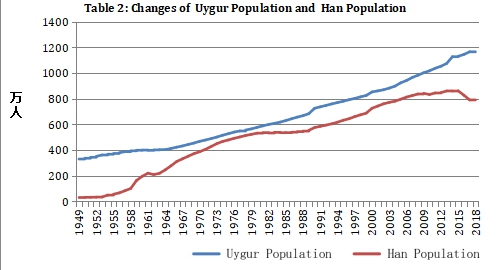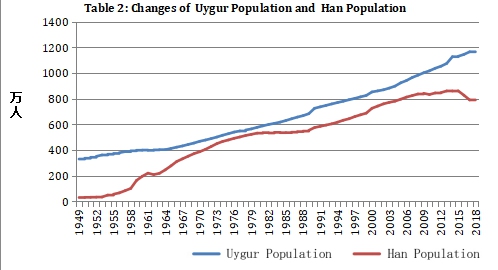
Photo: Xinhua
Recently, the population issue concerning Xinjiang has attracted much attention. Adrian Zenz, a German Anti-China scholar in particular, quoted data from unknown sources and pieced up his Research Report "Sterilizations, Intrauterine Devices and Compulsory Birth Control: the Chinese Communist Party's Campaign to Suppress the Birth Rate of Uyghurs in Xinjiang". The report falsely claims that "the natural population growth in Xinjiang has dropped sharply", and slanders that there is so-called "forced sterilization" in Xinjiang. In view of the wrong points and absurd logic of the report, this paper provides an overview of the population change in Xinjiang, analyses reasons for the rapid population growth in southern Xinjiang, and expounds the rationality of the general trend of population change in Xinjiang.
Analysis of Reasons for the Continuous Growth of the Total Population in XinjiangAt the time of the first national census in 1953, the total population of Xinjiang was 4.8736 million. According to the sixth national census in 2010, the figure registered 21.8158 million, an increase of 3.3 times in 57 years. In recent years, the total population of Xinjiang has kept growing steadily. The statistical data show that from 2010 to 2018, the population of ethnic minorities and that of the Uygurs in Xinjiang has witnessed steady growth, while that of the Han ethnic group in Xinjiang has slightly increased. In terms of population size, from 2010 to 2018, the permanent resident population of Xinjiang increased from 21.8158 million to 24.8676 million, an increase of 3.0518 million, or 13.99%. Among them, the population of ethnic minorities increased from 12.9859 million to 15.8608 million, an increase of 2.8749 million, or 22.14%; from the perspective of ethnic groups, the Uygur population increased from 10.1715 million to 12.7184 million, an increase of 2.5469 million, or 25.04%; the population of Han ethnic group increased from 8.8299 million to 9.0068 million, an increase of 176,900 people, or 2.0%. The growth rate of the Uygur population is higher than not only that of the regional in total, but also that of other ethnic minorities, and is obviously much higher than that of the Han population. From the perspective of growth areas, the population of four southern Xinjiang prefectures increased from 8.951 million to 10.355 million, an increase of 1.404 million, or 13.55% during that period, which is the fastest in Xinjiang.

Data sources: Fifty Years in Xinjiang (table 2-1), The Statistical Yearbook of Xinjiang over the years

Data sources: Fifty Years in Xinjiang (China Statistics Press, 2005,) table 2-3, The Statistical Yearbook of Xinjiang 2019 (table 3-8)
Since the founding of New China, the total regional population and ethnic minorities’ population in Xinjiang, especially the Uygur population, has maintained a rapid growth. In particular, the growth of Uygur population in southern Xinjiang is prominent. The reasons can be summarized as follows:
The long-term implementation of differential policies on Han and other ethnic groups. The Chinese government lawfully advocates family planning policy among all ethnic groups. Proceeding from the perspective of ensuring coordinated and sustainable development of ethnic minority population, it implements relatively loose policy on limiting the number of births by each couple for ethnic minorities, which is different from that for Han people. In 1975, Xinjiang started the implementation of the family planning policy in Urumqi and other cities where Han population was relatively concentrated. In 1981, with the publishing of Interim Provisions on Issues Concerning Family Planning, the implementation of family planning policy has been fully carried out among Han people. In 1992, the Family Planning Measures of Xinjiang Uygur Autonomous Region was issued, and a more lenient family planning policy on ethnic minorities was implemented: each Han couple in cities and towns were encouraged to give birth to one child only, while each Han couple in rural places were allowed to give birth to two children; whereas each ethnic minority couple in cities and towns were allowed to have two child, and in rural area, they were permitted to have three children. In 2017, with the improvement of economic and social development, and the convergence of the kid-bearing wishes of the people of all ethnic groups, Xinjiang revised its Regulations on Population and Family Planning, stipulating that all ethnic groups should implement a unified family planning policy, which is, a couple in urban areas can have two children, and a couple in rural areas can have three children. According to the sampling survey on national fertility and birth control in 1988 (2 ‰ samples surveyed), Uygur women in average had 6.13 children in their lifetime from 1970 to 1974, and 5.4 children from 1985 to 1987; whereas the Han women in the same area had 5.2 children and 2.5 children respectively during the two time periods. In 1981, Tibetans (5.84) and Uygurs (5.59) held the highest total fertility rate among all ethnic populations in China; in 1989, Uygurs (4.65) and Tibetans (3.80) were the highest again; in 2000, the highest total fertility rates went to Kazakhs (3.195), Uygurs (3.156), and Tibetans (2.755). It shows that the fertility rate of Uygurs has maintained at a higher level compared with other ethnic groups in China.
The improvement of health care has greatly reduced the mortality rate of the population. In the early days of the founding of new China, the mortality rate in Xinjiang was as high as 20 ‰. With the improvement of medical conditions, in the middle 1960s, the mortality rate dropped below 10 ‰ and continued to decrease later, with natural growth rate and birth rate changing basically in synchronization (see Figure 1). From 1949 to 1983, 232 people died in a Uygur populated village in Yingjisha County, Kashgar Prefecture. The average age of death was 18.76. Among them, 127 infants died within one year old, accounting for 54.74% of the total deaths. In 2016, the author investigated in the village and found that 8 people died in that year, with an average age of 73.9 years old. From 2014 to 2015, 282 babies were born in the village, and only one infant died. The physical quality of people of all ethnic groups in Xinjiang has been greatly improved, especially the health care level of women and children has been continuously improved. The maternal mortality rate has decreased from 43.41/100,000 in 2010 to 26.65/100,000 in 2018; the infant mortality rate has dropped from 26.58 ‰ to 14.02 ‰; and the average life expectancy has reached the age of 74.82 (data in 2015).
The family planning policy was not strictly implemented, resulting in the emergence of a large number of additional population. Affected by various factors, it was difficult to promote and implement family planning policy in Kashgar, Hotan and other southern Xinjiang areas for a long time, leading to the rapid population growth in those regions. Some locals there opposed the family planning policy because they insisted on their old childbearing concept and cognition, which hindered the implementation of the policy. Some religious extremists bewitched or even coerced people to get married by holding religious rites like “Nikah”, getting divorced by threefold repetition of “Talaq”. They claimed the marriage certificates issued by the government as “Haram”, and the termination of pregnancy as the practice of “Kafirs”. These extremists also incited locals to resist the family planning policy, resulting in prevailing early marriage and bigamy, and frequent unplanned births. In some areas, the family planning policy was not fully implemented with greater importance was given to reward the policy followers than to punish the violators, and to service than to management. Limited number of officials engaged in family planning work has also seriously affected the implementation of the policy. For example, one official in family planning work had to serve 15,000 residents on average in Shache County (Yarkand) of Kashgar, with the furthest couple living 130 km away. In 2015, special statistics on the implementation of the policy was carried out in a county in Kashgar Prefecture. It was reported that from 1989 to 2014, 359,000 people were born in the county, of whom 10.5% were unplanned births.
Cause Analysis on the Declining Trend of Population Growth in Xinjiang in 2018The birth rate and natural growth rate of Xinjiang population decreased from 15.88 ‰ and 11.40 ‰ in 2017 to 10.69 ‰ and 6.13 ‰ in 2018, respectively. Compared with 2017, the new-born population in 2018 decreased about 120,000. The main reasons are as follows.
Family planning policy is strictly practiced. According to the 2017 amendment of the Population and Family Planning Ordinance of Xinjiang Uyghur Autonomous Region, people of all ethnic groups in Xinjiang enjoy equal rights in family planning. Specifically, each registered urban couple is permitted to bear two children at most and each registered rural couple permitted to have three children at most. Any violation of the ordinance is subject to due penalty. In the meanwhile, special funds rewarding birth control and providing social security are appropriated by governments at county level and above for those who have already practiced the policy.Couples of ethnic minorities in Xinjiang rural areas who are willing to have only one or two children (adopted children included) in their lifetime, are eligible for applying for Certificate of Honor in Practicing Family Planning Policy. They could also receive a bonus of no less than 3000 RMB Yuan from the local government.In recent years, in order to enhance the quality of civic reproductive health, Xinjiang made constant efforts to improve services in birth control and reproductive health and spared no efforts in popularizing scientific knowledge in contraception and reproductive health. For example, there have been 9788 distribution sites so far in Xinjiang giving out condoms and other contraceptives materials free of charge. Seventeen types of contraceptives are offered annually for no charge; moreover, applications for smart phones are also developed to offer detailed information for sites providing contraceptives at prefecture, county and township levels, meeting individual needs for contraception and reproductive health. Safe, effective and appropriate contraceptive measures are available to couples of childbearing age, and fertile women accept tubal ligation and IUD operation spontaneously. In Hotan and other prefectures, the government follows the principle of combining people’s will with technical guidance, encouraging fertile women to choose internationally recognized tubal ligation and IUD operation which are slight in side effect, safe and effective. All the expenses of these operations are covered by the government.
The mindset on marriage and procreation has been shifted. In these years, young people in Xinjiang have already discarded the backward and outdated thoughts on mate selection and procreation. An increasing number of ethnic minority youths began to put more time and energy on personal development, thus postpone the time of first marriage. In 2015, there were 102 newlyweds in a township of Yengisar county, none of them were married at an early age. In fact,47 of them married late, a 23.9% increase over the previous year. In the meantime, deeply influenced by the conception of “the fewer and the better”, many married women of ethnic minorities in rural areas were able to go out finding jobs to earn more money, so the previous life cycle of “marriage-maternity-farming” has been broken and their status in family has been greatly enhanced, women have more chance than before to decide whether to have babies. With social development and progressing thoughts, the freedom of arranging one’s own marriage and the pursuit of happy marriage has become a commonplace. The rates of divorce and remarriage were stable with slight decline. According to official data, the numbers of registered divorced couples were 74979 in 2015, 51223 in 2017, and 47919 in 2018, with an annual decline of 14%; the numbers of remarried people in these years were 195008, 150628, and 115831, with an annual drop of 16%.
Religious extremism has been effectively curbed. In recent years, facing the tough challenges of severe and complicated anti-terrorism and eradicating extremism as well as people’s urgent need of cracking down on violent and terrorist crimes and ensuring the safety of life and property, Xinjiang government managed to liberate the minds of numerous people from the shackles of religious extremism, by addressing both symptoms and root causes and waging a war against extremism. The idea of civilized modern life has won popular support from the public. Those infected by religious extremism in the past were converted to enjoy the freedom to arrange their own marriage and accept legally registered marriage and contracted divorce rather than the previous religious ceremony of “chanting nikka to marry” and “chanting Talak to divorce”. They also abandoned the extremist thought of “Those who practice birth control and contraception are heretic” and embraced the idea of “Fewer and better birth brings lifelong happiness”, by which increased the awareness of lawfully obeying marital and obstetrical procedures of all ethnic groups. In the process of eradicating extremism, the minds of some women were emancipated, the scientific consciousness of gender equality and reproductive health has been promoted, making women not being reproduction machines any more. Women have been striving to become healthy, confident, independent, family-loving, patriotic, and modern in new era.
The Rationality of Population Change in XinjiangThe trends of world population suggested that the more developed the economy and society is, the stronger is people’s senses of realization of self-value and fostering better children, so the fertility rate and natural population growth rate will decrease correspondingly. According to the canonical demographic transition theory, human population will change from “high mortality rate, high birth rate and low growth rate” to “low mortality rate, low birth rate and low growth rate” with the development of human society. Since mid 1960’s, the birth rate of some European countries has showed a continuous dip, the total fertility rate amounting to 1.6 and even lower between 1980 and 1985. In the twilight of the 20th century, the birth rate of Europe as a whole was ultra-low. The total fertility rate of China had dropped to a rather low level in early 1990s and kept dropping. In 2015, the rate was 1.5-1.6.
Compared with national level, the demographic change in Xinjiang is typically featured by relative hysteresis and structural differences. With continuous economic and social development, the living conditions of people of all ethnic groups have showed fundamental changes, especially in travelling, housing, education, medical conditions and employment; the quality of population is therefore substantially enhanced. The birth rate, mortality rate and natural growth rate of population in Xinjiang dropped from 22.55‰, 7.69‰ and 14.86‰ in 1978 to 10.69‰, 4.56‰ and 6.13‰ in 2018 respectively. Based on the four-stage hypothesis of the demographic transition theory, the population of Xinjiang has come to the fourth stage, i.e., the stage of low mortality rate, low birth rate and low growth rate. In 2018, both fertility rate and natural growth rate of ethnic minority population (the Uygur population in particular) in Xinjiang decreased significantly. All of these can be attributed to the strict implementation of the family planning policy, and the acceleration of relatively hysteretic transition of ethnic minority population as a result of rapid economic and social development in recent years.
With the further promotion of poverty alleviation, the living conditions of poverty-stricken areas in south Xinjiang are greatly improved, and the process of urbanization apparently accelerated with continuously increasing urban population. People of all ethnic groups are better educated with cultural qualities better raised. The idea of late marriage-childbearing and fewer-better births have gained increasing popularity and become a new fad in southern Xinjiang. In the meantime, secular and modern lifestyle advocated in southern Xinjiang has already achieved remarkable results. The affection of backward ideas began to recede significantly, leaving wider space for individuals to make decision with stronger autonomy in controlling maternity. With the old concept of childbearing fading markedly, young women enjoy more autonomy for their childbearing. A safe conclusion can be drawn that the transition of Uygur population is achieved more by their own choice and autonomy than the guidance of policies and external forces. The transition is not only a matter of population size, but also a subject involving the overall improvement of population quality, which is the result of voluntary choice of people of all ethnic minorities.
By Li Xiaoxia, special researcher of Xinjiang Development Research Center






